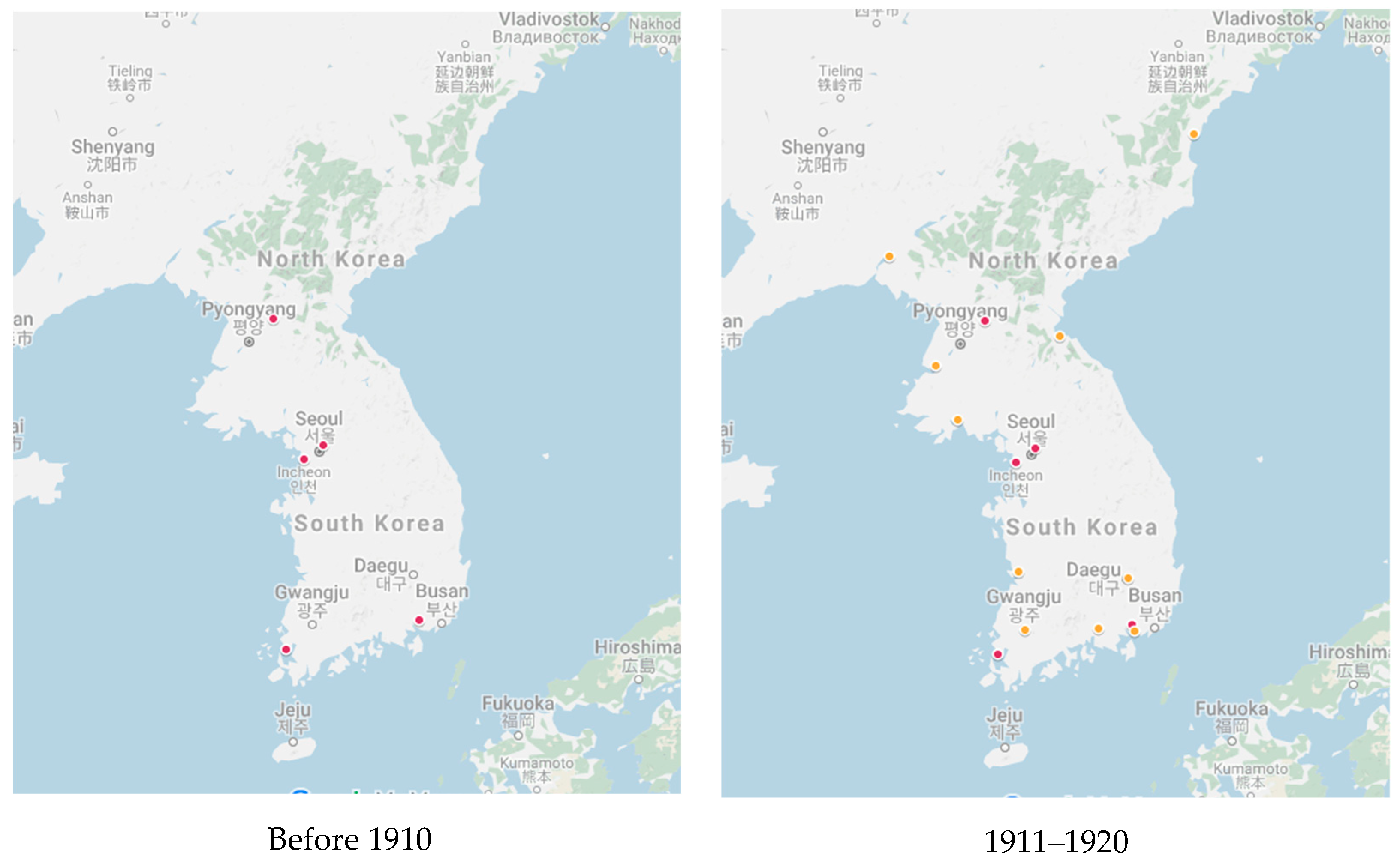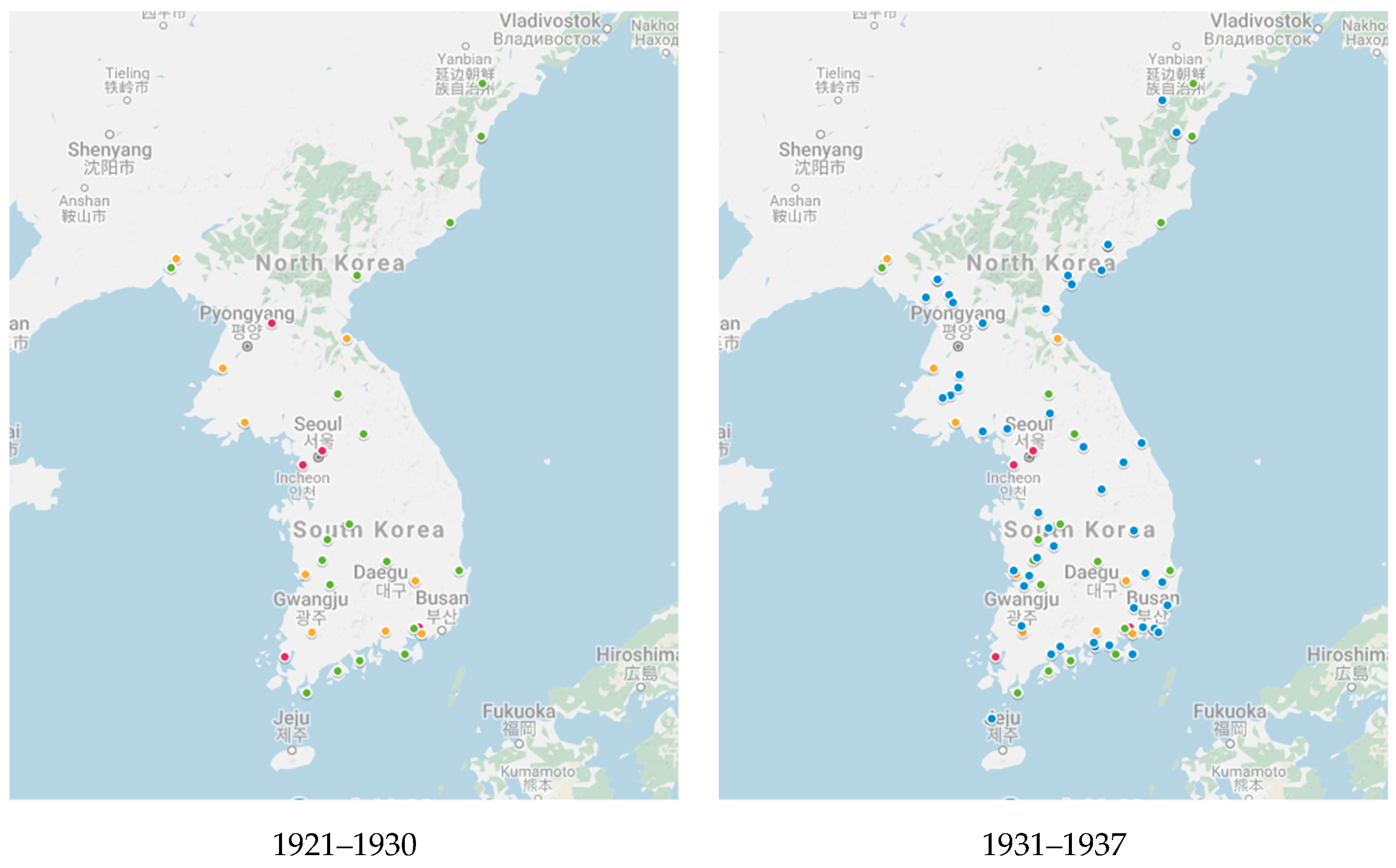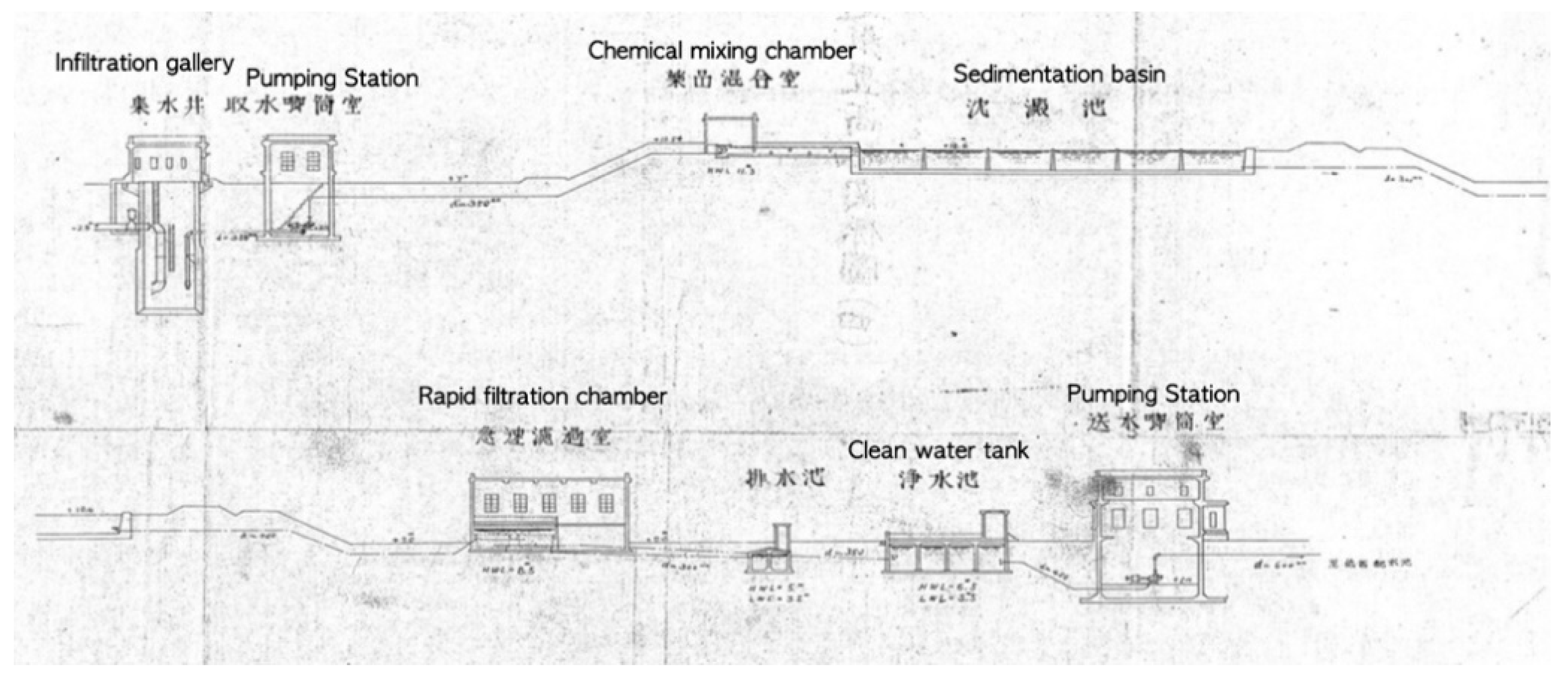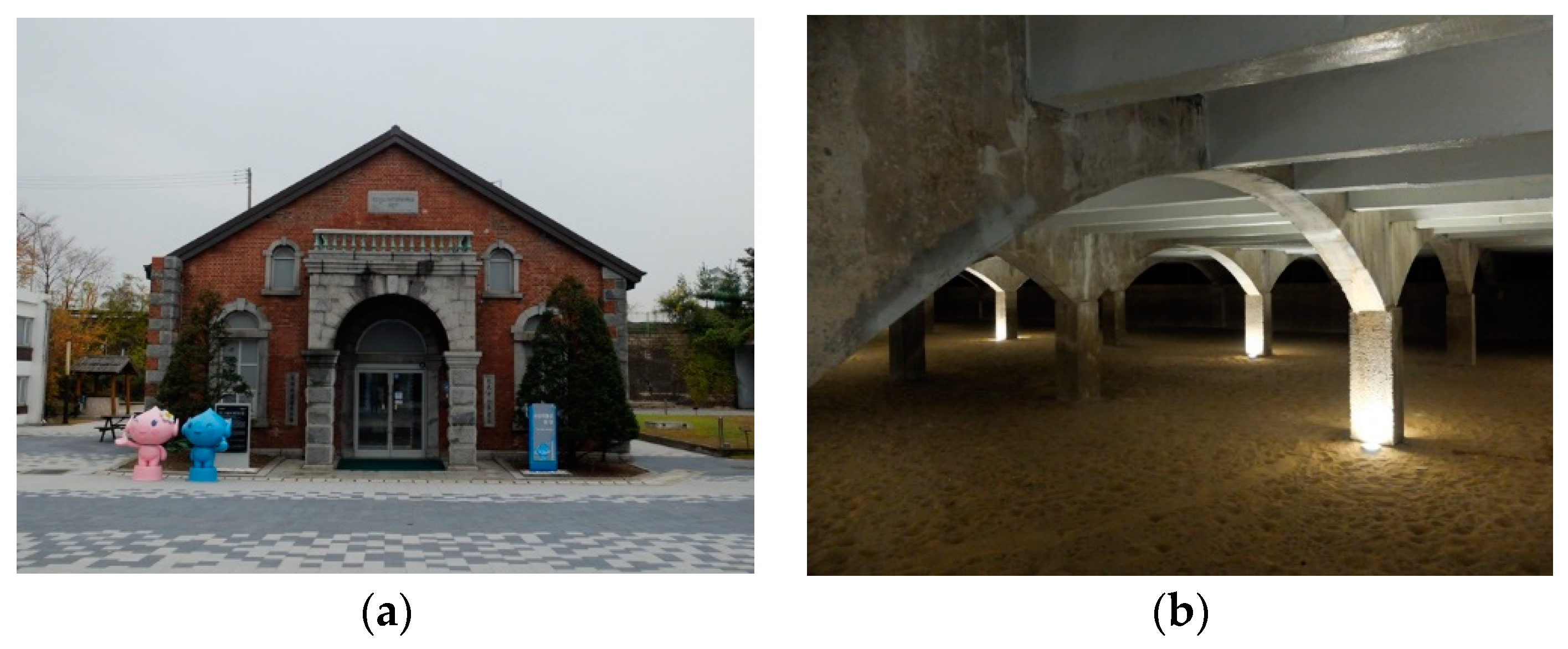Water Treatment Facilities as Civil Engineering Heritage from Guardian of Urban Sanitation to Symbol of Urban Colonial Modernity, in the Case of Ttukdo (Seoul) Water Purification Plant
Abstract
1. Introduction
1.1. Background and Purpose of Research
1.2. Literature Review, Research Materials, and Methods
2. Background: Installation and Modification of Korean Modern Waterworks
2.1. What Are Modern Waterworks?
2.2. Modern Korean Waterworks in the First Half of the Twentieth Century
3. Establishment and Modification of the Ttukdo Water Purification Plant in Seoul
3.1. Introduction of Modern Waterworks in Seoul
3.2. Improvement and Enlargement of Seoul’s Water Treatment Facilities
4. Transformation Process of Modern Waterworks into Civil Engineering Heritage
4.1. Modern Waterworks Heritage in Korea
4.2. Discarding and Finding Adoptive Uses for the Ttukdo Water Purification Plant
5. Historical Layers of Meaning in the Ttukdo Water Purification Plant
6. Conclusion: Continuing Value of the Ttukdo Water Purification Plant: From Guardian of Urban Sanitation to Symbol of Urban Colonial Modernity
- Continuity as a facility to produce clean water.
- Symbolic meaning as the guardians of urban sanitation.
Funding
Conflicts of Interest
References
- Rautenberg, M. Industrial heritage, regeneration of cities and public policies in the 1990s: Elements of a French/British comparison. Int. J. Herit. Stud. 2012, 18, 513–525. [Google Scholar] [CrossRef]
- TICCIH, The Nizhny Tagil Charter for the Industrial Heritage, ICOMOS, July 2003. Available online: https://www.icomos.org/18thapril/2006/nizhny-tagil-charter-e.pdf (accessed on 11 March 2019).
- Cultural Heritage Administration of Korea, Gendaemunhwayusaneul wihan Deungrokmunhwajae Jedo Annae. 2001. Available online: http://116.67.83.213/new_pdf/EM014390_01.pdf (accessed on 11 March 2019).
- Cultural Heritage Administration of Korea. Available online: http://heritage.go.kr/heri/cul/culDivView1.do?pageNo=5_1_3_0 (accessed on 30 April 2019).
- Kang, D.; Oh, S. Exploring of the Industrial Heritages Reuse Methods: With Focus on Japan Precedents. J. Urban Des. Inst. Korea Urban Des. 2003, 12, 59–71. [Google Scholar]
- Kim, B. Urban Sanitation Problems and Politics of Space in Colonial Seoul-focusing on Water Supply Sysyem. Sachong Historical J. 2009, 68, 191–226. [Google Scholar]
- Kim, Y. The problem of potable water and the public good in colonial Kyungseong (Seoul). Sahwiwayeoksa 2007, 73, 45–74. [Google Scholar]
- Joo, D. Implementation of Residential Water Metering System in the 1920s’ Kyongsung and Colonial “Publicness”. J. Korean Hist. 2016, 173, 253–296. [Google Scholar]
- Barlow, T.E. (Ed.) Formations of Colonial Modernity in East Asia; Duke University Press: Durham, NC, USA, 1997. [Google Scholar]
- Shin, G.; Robinson, M. (Eds.) Colonial Modernity in Korea; Harvard University Asia Center: Cambridge, MA, USA, 1997. [Google Scholar]
- Lee, H.; Cho, Y. Introduction: Colonial Modernity and Beyond in East Asian Contexts. Cult. Stud. 2012, 26, 601–616. [Google Scholar] [CrossRef]
- Kim, S. The Meaning and Extension Construction of Water Service of Japanese in Busan at the End of the Daehan Empire. J. Koreanol. 2009, 34, 237–276. [Google Scholar]
- Lee, Y.; Kim, S. Modern Sanitary Work and Urban Changes in Japanese Populated District in Seoul from 1885 to 1910. J. Archit. Inst. Korea 2012, 28, 215–224. [Google Scholar]
- Hamlin, C. Edwin Chadwick and the engineers, 1842–1854: Systems and anti-systems in the pipe-and-brick sewers war. Technol. Cult. 1992, 33, 680–709. [Google Scholar] [CrossRef] [PubMed]
- Douet, J. The Water Industry as World Heritage; The International Committee for the Conservation of the Industrial Heritage: Paris, France, 2018. [Google Scholar]
- Cotte, M. E Cultural Heritages of Water; ICOMOS: Paris, France, 2015; Available online: http://openarchive.icomos.org/1846/ (accessed on 15 March 2019).
- Douet, J. Briefing: Historical criteria for water industry heritage. Proc. Inst. Civ. Eng. Eng. Hist. Herit. 2019, 172, 94–96. [Google Scholar] [CrossRef]
- Ahn, K. A Study on Representation Method of Industrial Heritage from the Perspective of Functional System: Focused on Disused Water Treatment Plant in Seoul. Ph.D. Thesis, Seoul National University, Seoul, Korea, 2014. [Google Scholar]
- Chosensodofu. Suidokousi; Chosensodofu: Keijo, Korea, 1913. [Google Scholar]
- Chosensodofu. Chosendobokujigyousi; Chosensodofu: Keijo, Korea, 1937. [Google Scholar]
- Chosensodofukeikido. Chosensuidosuijitsunokenkyu; Chosensodofukeikido: Keijo, Korea, 1919. [Google Scholar]
- Keijofu. Keijosuidokakuchoukousikeikakusho; No. CJA0002664; National Archives of Korea: Keijofu, Korea, 1928.
- Keijofu. Keijosuidokakuchoukousisuienchikaishukukousisekkkeishou; No. CJA0014986; National Archives of Korea: Keijofu, Keijo, Korea, 1928.
- Keijofu. Suijitsushikenseisekishou; Keijofu: Keijo, Korea, 1919. [Google Scholar]
- Keijofu. Keijosuidokakuchoukousisuienchikaishukukousisekkkeishou; No. CJA0014757; National Archives of Korea: Keijofu, Keijo, Korea, 1928.
- Du, P.; Chen, H. Water supply of the cities in ancient China. Water Supply 2007, 7, 173–181. [Google Scholar] [CrossRef]
- Horikoshi, M. Suidonobunkasi-Edonosuido Tokyonosuido; Kashimasyuppankai: Tokyo, Japan, 1981. [Google Scholar]
- Yorke, T. Victorian Pumping Stations; Shire Publications: London, UK, 2018. [Google Scholar]
- Barraqué, B. The three Ages of Engineering for the Water Industry. Anuari de la Societat Catalana d’Economia 2004, 18, 135–152. [Google Scholar]
- Takahashi, Y.; Sakou, T. Nihonnodobokunorekishi; Chijinshokan: Tokyo, Japan, 1960. [Google Scholar]
- Takayose, S. Nihonkindaikoueisuidouseilitsusi; Nihonkeizaihyouronnsi: Tokyo, Japan, 2003. [Google Scholar]
- Hosono, I. Tokyoonkakooyobishourai; Kinkodo: Tokyo, Japan, 1902. [Google Scholar]
- Shin, D. Cholera Epidemics in Korea in the Late Choson, 1821–1910. Korean J. Hist. Sci. 1989, 11, 53–86. [Google Scholar]
- Keijofu. Keijofudobokujigyoukaiyou; Keijofu: Keijo, Korea, 1938. [Google Scholar]
- Huisman, L.; Wood, W.E. Slow Sand Filtration; World Health Organization: Geneva, Switzerland, 1974; Available online: http://www.who.int/water_sanitation_health/publications/ssf9241540370.pdf (accessed on 10 July 2019).
- Seoul Waterworks Authority. Seoulsangsudobaeknyunsa: 1908–2008; Seoul Waterworks Authority: Seoul, Korea, 2008. Available online: http://e-arisu.seoul.go.kr/story/history.jsp (accessed on 10 July 2019).
- Anonymous. Zettaianzennozousuiwokyokyusurukyusokurokasetsubi, keijonosuidouwanihonichi. Kyungsung Newspaper, 14 September 1933. [Google Scholar]
- Anonymous. Jesamjeongsujilsiheomgyulgwailjeoksuesegyunsubaekmi. DongA Newspaper, 1 March 1928. [Google Scholar]
- Anonymous. Euihakgyewadangkukjaganparanyagihansudomunje. DongA Newspaper, 19 March 1928. [Google Scholar]
- Ministry of Environment of Korea. Hankuksangsudobaeknyunsa: 1908–2008; Ministry of Environment of Korea: Kyungkido, Korea, 2008. Available online: http://library.me.go.kr/search/DetailView.ax?sid=1&cid=184118 (accessed on 10 July 2019).
- Avison, O.R.; Park, H. (Eds. & Trans); Memoires of Life in Korea; Chungnyunuisa: Seoul, Korea, 2010.
- Anonymous. Wisaengmunjeyogong. Hwangsung Newspaper, 13 September 1906. [Google Scholar]
- Anonymous. Daehansudohoisa. Daehanmaeil Newspaper, 24 March 1908. [Google Scholar]
- Seoul Metropolitan Governmetn Waterworks Museum. Available online: https://arisumuseum.seoul.go.kr/eng/m8_1_1.jsp (accessed on 22 September 2019).








| Types of Heritage | Location | Title | Original Function | Construction Date | Designation/Registration Date | Using as Waterworks | Current Usage |
|---|---|---|---|---|---|---|---|
| City Designated Heritage | Seoul | The first Ttukdo Water Purification Plant | Purification plant | 1908 | 1989 | Not using | Museum |
| Cultural Heritage Material | Incheon | Valve house of Songhyun service reservoir | Valve house | 1910 | 2003 | Not using | Public Park |
| Registered Cultural Heritage | Busan | Busan Seongjigok impounding reservoir | Impounding reservoir | 1910 | 2008 | Not using | Public Park |
| Busan | Bok Byeongsan service reservoir | Service reservoir | 1910 | 2007 | Not using | Public Park | |
| Gunsan | The bank of first impounding reservoir | Impounding reservoir | 1915 | 2005 | Using | ||
| Daegu | Daebong service reservoir | Service reservoir | 1918 | 2006 | Not using | Public Park | |
| Cheongju | Valve house of Dongbu service reservoir | Valve house | 1923 | 2007 | Not using | Public Park | |
| Ganggyeong | Chaewoonsan service reservoir | Filtration bed + Impounding reservoir | 1924 | 2014 | Not using | Not using | |
| Masan | Bongam impounding reservoir | Impounding reservoir | 1930 | 2005 | Not using | Public Park | |
| Tongyong | Munhwadong impounding reservoir | Filtration bed + Impounding reservoir | 1933 | 2005 | Using | ||
| Seoul | Gui the first and second purification plants | Purification plant | 1936/1959 | 2008 | Not using | Exhibition hall & Education facilities |
© 2020 by the author. Licensee MDPI, Basel, Switzerland. This article is an open access article distributed under the terms and conditions of the Creative Commons Attribution (CC BY) license (http://creativecommons.org/licenses/by/4.0/).
Share and Cite
Lee, Y. Water Treatment Facilities as Civil Engineering Heritage from Guardian of Urban Sanitation to Symbol of Urban Colonial Modernity, in the Case of Ttukdo (Seoul) Water Purification Plant. Sustainability 2020, 12, 511. https://doi.org/10.3390/su12020511
Lee Y. Water Treatment Facilities as Civil Engineering Heritage from Guardian of Urban Sanitation to Symbol of Urban Colonial Modernity, in the Case of Ttukdo (Seoul) Water Purification Plant. Sustainability. 2020; 12(2):511. https://doi.org/10.3390/su12020511
Chicago/Turabian StyleLee, Yeonkyung. 2020. "Water Treatment Facilities as Civil Engineering Heritage from Guardian of Urban Sanitation to Symbol of Urban Colonial Modernity, in the Case of Ttukdo (Seoul) Water Purification Plant" Sustainability 12, no. 2: 511. https://doi.org/10.3390/su12020511
APA StyleLee, Y. (2020). Water Treatment Facilities as Civil Engineering Heritage from Guardian of Urban Sanitation to Symbol of Urban Colonial Modernity, in the Case of Ttukdo (Seoul) Water Purification Plant. Sustainability, 12(2), 511. https://doi.org/10.3390/su12020511





